If anything is predictable in Florida it is that each summer the weather will be very warm and humid, and everyone should be keeping an eye on the tropics and preparing for Hurricane Season.
The 2024 Atlantic Hurricane Season runs from June 1 to Nov. 30. With a history of these storms producing destruction in the region, just the mention of Hurricane Ian (2022), Hurricane Irma (2017), or Hurricane Charley (2004), can cause misery for many.
The Diocese of Venice, and many families are still recovering from Hurricane Ian nearly two years after the storm passed, but Bishop Frank J. Dewane said the Diocese of Venice is well-prepared for the coming season.

“We are all well aware of the catastrophic impacts of hurricanes as witnessed by the destruction caused during Hurricane Ian and other storms,” Bishop Frank J. Dewane said. “What we can do is to be prepared, and pray for protection. My prayers are especially for the people who continue to recover from previous storms. As the new Atlantic Hurricane Season arrives, let us all ask God for protection and safety from these storms in this year and beyond.”
Experts at the National Oceanic and Atmospheric Administration (NOAA) is forecasting a range of 17 to 25 total named storms (winds of 39 mph or higher), well above the seasonal average. This follows the 2023 season which produced 20 named storms, including Hurricane Idalia, which threatened Southwest Florida before slamming into north Florida. NOAA stated that numerous factors were considered in the forecast, including near-record warm ocean temperatures in the Atlantic Ocean, development of La Nina conditions in the Pacific, reduced Atlantic trade winds and less wind shear, all of which tend to favor tropical storm formation, reported.
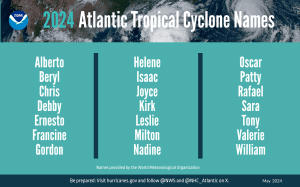
The names for this season, provided by the World Meteorological Organization (WMO), include Alberto, Beryl, Chris, Debby, Ernesto and others. The list of 21 names is repeated every six years. The only time that there is a change is if a storm is so deadly or costly that the future use of its name on a different storm would be inappropriate for obvious reasons of sensitivity (Ian, Irma, Charley, Katrina, etc.). If that occurs, then at an annual WMO meeting by the committee (called primarily to discuss many other issues) the offending name is stricken from the list and another name is selected to replace it. The new names on the 2024 list are Francine and Milton, replacing Florence and Michael. In 2018, Michael caused catastrophic damage to Florida’s Panhandle, while Florence caused widespread flooding in South Carolina, North Carolina, Virginia, Maryland and beyond.
Weather forecasters and emergency management officials stress that each tropical system is different, explaining that just because you survived Ian, Irma or Charley, without any damage doesn’t mean the next storm, whether it is a tropical storm or major hurricane, couldn’t destroy everything around you.
A recently published NOAA analysis of Hurricanes Ian and Charley, which both made landfall with winds of in excess of 150 mph and followed nearly identical tracks, caused very different devastation. Charley was a small storm (wind impacts), moving fast which meant there was little storm surge, yet it still caused 35 deaths and $16.9 billion in damage. The wind field of Ian was five times the size of Charley, was slow moving, had up to 15-foot storm surge in some areas, triggered catastrophic flooding, and caused 141 deaths and $113 billion in damage.
This emphasizes the importance of paying attention to tropical cyclone size and not just comparing track and intensity of previous hurricanes. The National Hurricane Center and National Weather Service take into account storm size when issuing watches and warnings, so it is highly advised that individuals use those when making decisions about protecting themselves, their families, and properties.
In its report, NOAA stated, “the bottom line is that forecasters understand how storm size can affect hazards and it is good practice to pay attention to forecasts rather than comparing the current event with previous storms or experiences.”
With many people no longer watching local news, NOAA officials also stress the need for everyone to have access to reliable local weather reports to avoid confusion when a storm approaches. This can be accessed through the National Weather Service, National Hurricane Center, local news outlets or other trustworthy weather sources.
While keeping a wary eye on the weather forecast is important, being prepared before storms approach is just as vital. Preparedness means many things, but a key part is simply knowing where you live in relationship to evacuation zones in your city or county. Also, knowing how well constructed your home is can also impact your preparations and planning in the event an evacuation is ordered. Also, as many learned during Ian, power could be out for days, or weeks, following a storm, and the decision must also be made if one wants to stay under those conditions.





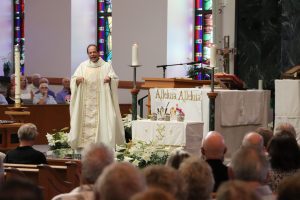 “Wonderful!” “It’s true, we are home!” “Our prayers have been answered!” “What a glorious moment!” These are just some of the comments made as people entered the Church for the first time on Easter Sunday. Most looked up, knowing that on Sept. 10, 2017, when the fierce winds of Irma struck, a large section of the roof was blown off allowing water to flow in and severely damage the sanctuary.
“Wonderful!” “It’s true, we are home!” “Our prayers have been answered!” “What a glorious moment!” These are just some of the comments made as people entered the Church for the first time on Easter Sunday. Most looked up, knowing that on Sept. 10, 2017, when the fierce winds of Irma struck, a large section of the roof was blown off allowing water to flow in and severely damage the sanctuary.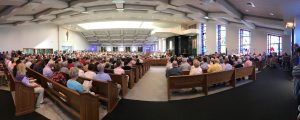 Martie Granieri sings in the Parish Choir and was overjoyed that the Church opened in time for Easter. “Christ is where you find Him. He was in our gymnasium (which served as a temporary Church while repairs were made), He is where we gather in His name,” Granieri said. “But this place; the Church,
Martie Granieri sings in the Parish Choir and was overjoyed that the Church opened in time for Easter. “Christ is where you find Him. He was in our gymnasium (which served as a temporary Church while repairs were made), He is where we gather in His name,” Granieri said. “But this place; the Church, 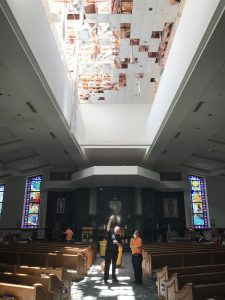 is where we know Him best. We are so happy to be back.”
is where we know Him best. We are so happy to be back.”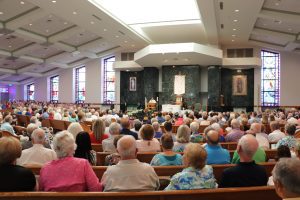 “We are very Blessed by Almighty God to be here,” said Father Russell Ruggiero, Parish Administrator, prior to Easter Sunday Mass to a standing room only crowd. “It is as people said, it is a Resurrection.”
“We are very Blessed by Almighty God to be here,” said Father Russell Ruggiero, Parish Administrator, prior to Easter Sunday Mass to a standing room only crowd. “It is as people said, it is a Resurrection.”